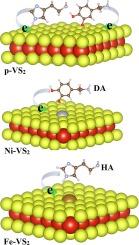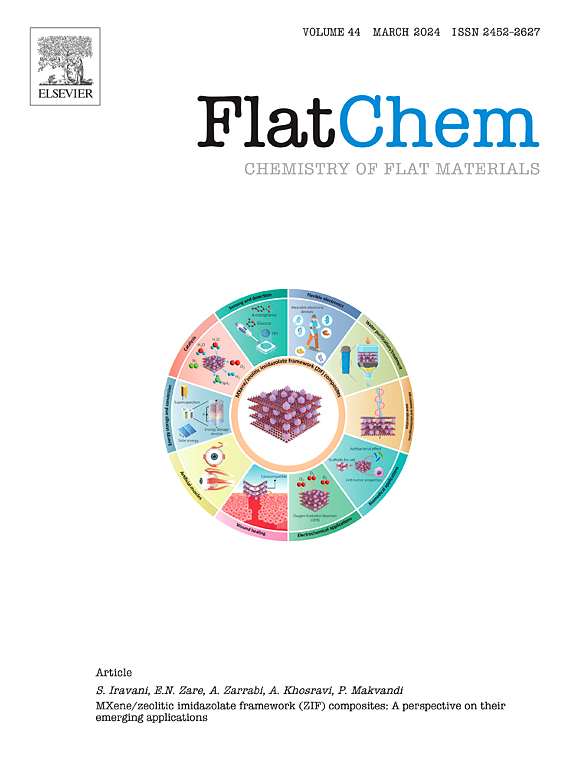揭示二硫化二钒(VS2)纳米片对特定神经递质的高效传感特性:DFT 展望
IF 5.9
3区 材料科学
Q2 CHEMISTRY, PHYSICAL
引用次数: 0
摘要
设计基于超薄材料的高效纳米传感器来检测神经递质对于生物传感应用至关重要。在这项工作中,利用自旋极化密度泛函理论(DFT)计算,使用轻过渡金属二卤化物、二硫化钒(VS2)纳米片研究了所选神经递质(如多巴胺(DA)和组胺(HA))的结构、电子、磁性和吸附。结果表明,DA 和 HA 在原始(p-VS2)和单硫(S)空位诱导(SV-VS2)上的吸附相对较弱。然而,引入选定的过渡金属(TMs)掺杂剂,如钴(Co)、铁(Fe)和镍(Ni),可显著改善 DA 和 HA 的吸附。在所研究的体系中,掺镍的 VS2(掺铁的 VS2)对 DA(HA)的吸附力最强,吸附能为 -2.00 (-1.28) eV,有望用于实际传感应用。电荷分析表明,DA 和 HA 都是掺杂了 TMs 的 VS2 的电荷供体。吸附 DA/HA 后,掺杂 TMs 的 VS2 的电子结构和磁性能发生了可量化的变化,研究人员通过带状结构、自旋极化态密度和功函数计算对这些变化进行了研究。最后,为了在不同压力和温度条件下实现实际检测能力,我们采用了朗缪尔吸附模型。结果发现,掺杂了 TMs 的 VS2 能分别在几十 ppt 到 ppm 的浓度范围内检测到 DA 和 HA。我们坚信,我们的研究结果将有助于开发基于掺杂 TMs 的 VS2 纳米片的高效纳米传感器,用于检测 DA 和 HA。本文章由计算机程序翻译,如有差异,请以英文原文为准。

Uncovering efficient sensing properties of vanadium disulfide (VS2) nanosheets towards specific neurotransmitters: A DFT prospective
Designing efficient nanosensors based on ultrathin materials for the detection of neurotransmitters is crucial for biosensing applications. In this work, using spin-polarized density functional theory (DFT) calculations, structural, electronic, magnetic, and adsorption of the selected neurotransmitters, such as dopamine (DA) and histamine (HA), were investigated using light transition metals dichalcogenides, vanadium disulfide (VS2) nanosheets. It was revealed that DA and HA adsorbed relatively weakly on pristine (p-VS2) as well as single sulfur (S) Vacancy-induced (SV-VS2). However, the introduction of selected transition metals (TMs) dopants, such as cobalt (Co), iron (Fe), and nickel (Ni), significantly improved the adsorption of DA and HA. Among the studied systems, Ni-doped VS2 (Fe-doped VS2) exhibited the strongest adsorption toward DA (HA) with an adsorption energy of −2.00 (−1.28) eV, which is promising for practical sensing applications. Charge analysis revealed that both DA and HA acted as charge donors to the TMs-doped VS2. Upon DA/HA adsorptions, quantifiable variations were observed in the electronic structures and magnetic properties of TMs-doped VS2, which were studied through band structures, spin-polarized density of states, and work function calculations. Lastly, for the practical detection capabilities at diverse pressure and temperature settings, we employed the Langmuir adsorption model. It was found that TMs-doped VS2 detected DA and HA at concentrations ranging from tens of ppt to ppm levels, respectively. We strongly believe that our findings will contribute towards the development of highly effective nanosensors based on TMs-doped VS2 nanosheets for the detection of DA, and HA.
求助全文
通过发布文献求助,成功后即可免费获取论文全文。
去求助
来源期刊

FlatChem
Multiple-
CiteScore
8.40
自引率
6.50%
发文量
104
审稿时长
26 days
期刊介绍:
FlatChem - Chemistry of Flat Materials, a new voice in the community, publishes original and significant, cutting-edge research related to the chemistry of graphene and related 2D & layered materials. The overall aim of the journal is to combine the chemistry and applications of these materials, where the submission of communications, full papers, and concepts should contain chemistry in a materials context, which can be both experimental and/or theoretical. In addition to original research articles, FlatChem also offers reviews, minireviews, highlights and perspectives on the future of this research area with the scientific leaders in fields related to Flat Materials. Topics of interest include, but are not limited to, the following: -Design, synthesis, applications and investigation of graphene, graphene related materials and other 2D & layered materials (for example Silicene, Germanene, Phosphorene, MXenes, Boron nitride, Transition metal dichalcogenides) -Characterization of these materials using all forms of spectroscopy and microscopy techniques -Chemical modification or functionalization and dispersion of these materials, as well as interactions with other materials -Exploring the surface chemistry of these materials for applications in: Sensors or detectors in electrochemical/Lab on a Chip devices, Composite materials, Membranes, Environment technology, Catalysis for energy storage and conversion (for example fuel cells, supercapacitors, batteries, hydrogen storage), Biomedical technology (drug delivery, biosensing, bioimaging)
 求助内容:
求助内容: 应助结果提醒方式:
应助结果提醒方式:


